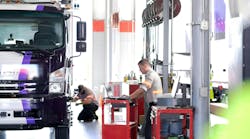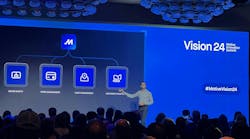3D seems silly and scientific, passé and cutting edge at the same time. It calls to mind the cardboard glasses with one red and one green lens that first enabled moviegoers at the Ambassador Hotel Theatre in Los Angeles on Sept. 27, 1922, to see images “come right off the theatre screen,” and continues with today’s ultra-everything video games, 3D television and (still more) 3D movies. Now, after decades in the entertainment business, however, 3D is also pursuing a real day job—mapping.
Apple set the software world abuzz in June when it unveiled the next generation of its mobile operating system, iOS 6, and its own digital maps service, replacing the Google Maps that have been a preinstalled feature on iPhones from the beginning. Both Google Earth and now Apple utilize 3D imagery to bring flat maps to life, instantly changing the familiar colored lines and symbols of one-dimensional maps into more “realistic” views of the road or the landscape ahead, as seen from the ground or from the air.
Users can tilt maps, pan views, zoom in and out, or even fly over major metropolitan areas, checking out the sights and scenery from above. Apple, in fact, calls its new aerial perspective feature “Flyover.”
It is perhaps not surprising, though, that opinions are mixed and enthusiasm muted concerning whether 3D will find a leading role in the trucking industry’s mission-critical routing and navigation business or play a lesser or even behind-the-scenes part. Sure, it looks exciting, the thinking goes, but can 3D really deliver value in a business as demanding as trucking?
“We try to be adaptive and to keep at the forefront of new developments,” notes Dan Titus, vice president, business development-North America, enterprise solutions for ALK Technologies, “and, of course, any preinstalled mapping and navigation application might be a potential competitor. When you are talking about 3D, however, it looks like much more of a consumer play… at least today. From a driver perspective, when was the last time you really needed to see a 3D view of where you were headed? We’ve had no requests at all that I know of.”
Besides the no-pressing-need obstacle to adding 3D capabilities to maps for use by commercial fleets, there are other issues as well. They include distracted driving as it impacts driver safety, and various technical problems like processing speed and data storage on mobile devices. What’s more, today’s industry-specific routing and navigation tools are already extremely sophisticated in their own right, delivering appropriate information on an as-needed basis.
Still, mapping and routing is at a very dynamic and changing period in its development, one with plenty of new jobs to tackle—maybe even for 3D.
“The product that is the safest and the most accurate, that saves companies money and is accepted and used by drivers is [the best routing and navigation solution],” says Rick Turek, former CTO and co-founder of Maptuit, and now vice president of engineering for Telogis, which recently acquired the company. “Drivers are not supposed to be watching a navigation screen while they are going down the road. A very quick glance is all that should be required, or all-audio input [so they never have to look away].
“I would not be surprised to see regulations limiting what information is presented to the driver and when,” he adds. Neither would others.
“Information for drivers will probably have to be managed according to whether the vehicle is moving,” says Mason Meadows, director of product development for Rand McNally. “Not actually showing drivers complex maneuvers ahead, but just giving them verbal warnings is probably better. We already have a ‘Safe Mode’ where we suppress some data to simplify the driving experience. [Going forward] we will be sensible and work to make sure driver information is simplified and easy to use.”
“Distracted driving is a huge issue,” agrees Titus. “The importance of driver safety can’t be overemphasized. From an ALK perspective, driver safety has always been a core assumption. We don’t want information overload [in the cab]. We’ve added text-to-speech technology to try to keep communication to a minimum. The question is, ‘What information do you need to provide to a driver and when?’ You don’t even want to say too much or to provide information at inappropriate times.”
Sent to the back office
The need to protect drivers from potentially distracting information overload probably means that 3D is more apt to find a job in a fleet’s back office than it is in the truck cab, at least in the short term.
“Google and Apple set what people come to expect from products,” observes John McAvoy, director of GIS Engineering for Rand McNally. “Things like 3D and flyover features could help people see some things better perhaps, but flyover as it relates to truck routing and navigation is probably more useful to the back office than it is in the cab—at least while the vehicle is in motion.”
Driver coaching is one area, for instance, where McAvoy sees some potential for 3D. “We already have the ability to overlay a map with a satellite image,” he says, “so you can see where a truck is from an aerial view. One big area of interest for our customers is giving them the ability to better monitor, visualize, measure and analyze driver behaviors, especially things like speeding or hard-braking.
“Showing a driver a map where these behaviors occurred is good, but showing them the satellite image over the map is even better,” McAvoy adds. “It is almost like you were looking over the driver’s shoulder. For instance, we saw data showing a driver for one of our customers jamming on the brakes four days in a row at the exact same spot. It ended up being because there was a very steep, sharp turn right there that he was approaching too fast. In counseling the driver, it was helpful to be able to show him exactly what was taking place.
“I can imagine that 3D might make it easier to really see something,” he continues. “For instance, a road along the coast is just a line on a regular map, but a 3D map could show that it is actually a very narrow road carved into the side of a cliff. Street-level 3D views might also be useful to P&D drivers, [especially if they are learning a new route].
“Seeing a geofenced area is incredibly intuitive when you add a satellite overlay to a map. It is a very frequently used capability of our system today,” McAvoy notes. “3D might make it even easier to see the geofence, to see how terrain impacts things. As far as I know, however, these capabilities are not really available yet, except for Google Earth, which uses satellite imagery draped over digital terrain models [to create the 3D effect].”
According to TomTom, “3D [in maps] is not about reproducing the world, but it is made to add relevance to the user interface and to enhance the end user experience.” Not a bad job reference.
Eco-routing
One potentially relevant and useful new tool involves the convergence of data about the topography of the road ahead with an intelligent cruise control system that can automatically control speed and braking and even regulate the transmission. In Stuttgart, Germany, for example, Daimler introduced a cruise control system in May for its new Mercedes-Benz Actros (a model not offered in the U.S.). According to the company, “because the system is familiar with the topography of the road ahead, it is able to respond in a way that will deliver the most fuel-efficient performance.”
A GPS-based cruise control system, “Predictive Powertrain Control” not only intervenes to control speed and braking but can also handle shifting. Daimler credits the new system with improving fuel efficiency by up to 3% in the Actros. The U.S. saw an earlier version of this capability (with speed control only) in 2009 as an option in certain Freightliner models.
Incorporating topographical information into roadmaps is also a subject of interest to ALK, says Dan Titus. “We have a lot of commercial truck business in Europe and North America,” he says, “and we are always trying to get a good feel for what the next demands from those markets will be. We have heard from multiple partners that eco-routing is of keen interest for fuel management, safety and reducing maintenance costs.
“Off-road data is another area where we are working,” he adds. Fracking operations, for instance, need to direct truck and other equipment operators over areas without roads or directional signage.
There are, however, practical considerations, he notes. “Whether you are talking about topographical information or 3D, it means more data gets added, and that increases the size of the application on your mobile device,” Titus says. “Memory space and processing power, at some point, become an issue. You also have to be careful about what data and how much gets presented to the driver. And it can’t all just sit on a server if you want 100% reliability.”
According to Titus, that means asking some tough questions about how value can be added by using topographical, satellite or 3D imagery. “Can you really afford to put it on a mobile device?” he asks. “Does the customer really want to pay to download it?
“At ALK, we will process more data to create ever more robust routing tools, but the maps, to the driver, will look much the same,” he adds. Many of the new capabilities will be deployed behind the scenes to factor in lots of additional information about routes, including data on things like the terrain, traffic and the weather.
“With CoPilot Truck 9, users already have the ability to import site-specific data, such as preferred entrances to a facility,” Titus says. “They can pinpoint the location of a particular dock with latitude and longitude data or use the customized ‘points of interest’ (POI) feature to add to the millions of POIs already included.”
AVOIDING DISTRACTIONS
At Telogis, Rick Turek offers a similar view. Adding terrain and elevation data to maps would be a plus, he notes. In fact, the company can add elevation information to maps now as a “modifier.”
“In the near future, [our system] will be able to give drivers access to the terrain data they really need,” he says, “but we are not going to just ‘nag’ drivers by providing so much information that they quit listening. A topographical map with contour lines is just a distraction to me. I would prefer to understand what it is that drivers need to know and provide them with just that.
“The neat thing about software-as-a-service is that you can do all kinds of computational things behind the scenes to help the driver on the server side,” Turek adds. “Everything does not have to be on the mobile device.”
“It is a very exciting business these days,” observes Titus. “Devices have more memory and faster processors and users have more needs for more navigation applications.”
All the excitement around digital mapping in 2D or 3D does not mean that paper maps are headed the way of the slide rule and 10-key calculator, however, at least not according to Rand McNally, long-time supplier of the popular Road Atlas for truckers. “We are not seeing a big migration away from the printed Road Atlas,” says Amy Krouse, head of commercial truck marketing for the company. “People really like the view paper maps provide; they like the scale for planning long-distance trips and they like knowing that the paper map is there if they need it.”


